Green Energy Management in Manufacturing Based on Demand Prediction by Artificial Intelligence—A Review
Abstract
1. Introduction
2. Sustainable Manufacturing System Design
- Improving system efficiency and productivity as well as cost balance;
- Minimizing the impact on the environment, also indirectly by reducing energy consumption and CO2 emissions;
- Reducing production losses and the amount of waste [4].
- The measurement of energy consumption, CO2 emissions, and other factors using various energy sources (both for powering machines, lighting, heating, water heating, cooling, etc.: crude oil, oil, solar energy, etc.);
- A mathematical model taking into account real-world constraints, including technological, economic, and ecological ones, with the objective function (with weights specific to a given enterprise/industry) minimizing costs, energy consumption, and CO2 emissions within the production system itself and the entire enterprise;
- Determining the uncertainty (also: randomness characteristics, if necessary) of input parameters using, e.g., a fuzzy model (including directed fuzzy numbers);
- Analyses and decisions regarding the number of machines/devices for each stage of the production process in connection with the amount of energy and material flow and their DT;
- The construction of an optimizing AI/ML model;
- The validation of the developed system model based on real data, e.g., case study;
- Inclusion at the earliest possible stage of planning and design;
- Allows to fully explore the inclusion of ecological (e.g., energy consumed) and economic aspects;—It involves the operations of the production system;
- Uses computer simulation tools;
- It would provide a framework for a hybrid approach to optimization;
3. Materials and Methods
3.1. Dataset
- Research Question 1 (RQ1): the evolution of research topics/issues over time;
- RQ2: the geographical distribution of research/publications;
- RQ3: the authors and publications with the greatest influence;
- RQ4: the identification of cooperation networks between researchers and institutions;
- RQ5: the topics that may shape future research agendas.
3.2. Methods
4. Results
5. Discussion
5.1. Limitations of Previous Studies
- Implementing AI and advanced demand forecasting systems requires significant investment in technology solutions and staff skills;
- Integrating AI-based systems with the existing production processes and legacy systems can be complex and time-consuming;
- Data quality and availability can be limited, and comprehensive data collection in production environments can be difficult—in addition, handling and processing large amounts of data for AI applications can create significant data privacy and security issues;
- Scaling AI solutions across different manufacturing plants and systems can be difficult due to varying levels of technological sophistication;
- AI/ML systems are difficult to understand and trust their predictions, including for critical manufacturing decisions;
- AI systems can consume significant amounts of energy;
- Rapidly changing market demands may exceed AI’s adaptability, leading to inefficiencies in energy management;
- The regulatory challenges for both the AI Act and green energy management can be complex and vary greatly from region to region/country to country;
5.2. Directions for Further Research
- Improved data collection methods, including advanced sensors and IIoT devices to improve the accuracy and detail of data collection;
- The creation of new ML algorithms tailored to complexity and specific needs;
- Hybrid models created by combining artificial intelligence with traditional forecasting methods to improve the reliability and accuracy of forecasts;
- Developing methods to increase the transparency and understanding of AI forecasts;
- Exploring ways to reduce the energy consumption of AI systems themselves;
- Developing a framework for integrating AI-based demand forecasting systems with the existing energy production and management systems;
- Strengthening cyber-security measures to protect against breaches and attacks on sensitive data;
6. Conclusions
Author Contributions
Funding
Data Availability Statement
Conflicts of Interest
References
- Rojek, I.; Mroziński, A.; Kotlarz, P.; Macko, M.; Mikołajewski, D. AI-Based Computational Model in Sustainable Transformation of Energy Markets. Energies 2023, 16, 8059. [Google Scholar] [CrossRef]
- Rojek, I.; Mikołajewski, D.; Mroziński, A.; Macko, M. Machine Learning- and Artificial Intelligence-Derived Prediction for Home Smart Energy Systems with PV Installation and Battery Energy Storage. Energies 2023, 16, 6613. [Google Scholar] [CrossRef]
- Diaz, J.L.; Bermeo, M.; Diaz-Rozo, J.; Ocampo-Martinez, C. An optimization-based control strategy for energy efficiency of discrete manufacturing systems. ISA Trans. 2019, 93, 399–409. [Google Scholar] [CrossRef] [PubMed]
- Nujoom, R.; Mohammed, A.; Wang, Q. A sustainable manufacturing system design: A fuzzy multi-objective optimization model. Environ. Sci. Pollut. Res. Int. 2018, 25, 24535–24547. [Google Scholar] [CrossRef]
- Yessengaliyev, D.A.; Zhumagaliyev, Y.U.; Tazhibayev, A.A.; Bekbossynov, Z.A.; Sarkulova, Z.S.; Issengaliyeva, G.A.; Zhubandykova, Z.U.; Semenikhin, V.V.; Yeskalina, K.T.; Ansapov, A.E. Energy Efficiency Trends in Petroleum Extraction: A Bibliometric Study. Energies 2024, 17, 2869. [Google Scholar] [CrossRef]
- Naseri, K.; Noorpoor, A.; Razavian, F.; Khoshmaneshzadeh, B. Life Cycle Assessment of Crude Oil Processing by Energy Management Approach. Pollution 2023, 9, 183–194. [Google Scholar] [CrossRef]
- Midor, K.; Ivanova, T.N.; Molenda, M.; Biały, W.; Zakharov, O.V. Aspects of Energy Saving of Oil-Producing Enterprises. Energies 2021, 15, 259. [Google Scholar] [CrossRef]
- Nujoom, R.; Mohammed, A.; Diabat, A. Manufacturing system reconfiguration towards sustainable production: A novel hybrid optimization methodology. Environ. Sci. Pollut. Res. Int. 2023, 30, 110687–110714. [Google Scholar] [CrossRef]
- Agote-Garrido, A.; Martín-Gómez, A.M.; Lama-Ruiz, J.R. Manufacturing System Design in Industry 5.0: Incorporating Sociotechnical Systems and Social Metabolism for Human-Centered, Sustainable, and Resilient Production. Systems 2023, 11, 537. [Google Scholar] [CrossRef]
- Ostovari, A.; Benyoucef, L.; Benderbal, H.H.; Delorme, X. Robust Configuration Design of Sustainable Reconfigurable Manufacturing System under Uncertainty. In Proceedings of the 2023 IEEE International Conference on Networking, Sensing and Control (ICNSC), Marseille, France, 25–27 October 2023; pp. 1–7. [Google Scholar]
- Nujoom, R.; Mohammed, A.; Wang, Q. Drafting a cost-effective approach towards a sustainable manufacturing system design. Comput. Ind. Eng. 2019, 133, 317–330. [Google Scholar] [CrossRef]
- Khezri, A.; Benderbal, H.H.; Benyoucef, L. A Sustainable Reconfigurable Manufacturing System Designing with Focus on Environmental Hazardous Wastes. In Proceedings of the 2019 24th IEEE International Conference on Emerging Technologies and Factory Automation (ETFA), Zaragoza, Spain, 10–13 September2019; pp. 317–324. [Google Scholar]
- Nujoom, R.; Wang, Q.; Mohammed, A. Towards a sustainable manufacturing system design: A multi-objective optimization model. In Proceedings of the 2017 23rd International Conference on Automation and Computing (ICAC), Huddersfield, UK, 7–8 September 2017; pp. 1–8. [Google Scholar]
- Giret, A.; Trentesaux, D. Artefacts and Guidelines for Designing Sustainable Manufacturing Systems. InService Orientation in Holonic and Multi-Agent Manufacturing; Springer: Berlin/Heidelberg, Germany, 2015; pp. 93–101. [Google Scholar]
- Jafarzadeh, J.; Amoozad Khalili, H.; Shoja, N. A Multiobjective Optimization Model for a Dynamic and Sustainable Cellular Manufacturing System under Uncertainty. Comput. Intell. Neurosci. 2022, 2022, 1334081. [Google Scholar] [CrossRef]
- Xames, M.D.; Shefa, J.; Azrin, F.A.; Uddin, A.S.M.N.; Habiba, U.; Zaman, W. A systematic review of modeling approaches in green supply chain optimization. Environ. Sci. Pollut. Res. Int. 2023, 30, 113218–113241. [Google Scholar] [CrossRef]
- Shahar, F.S.; Sultan, M.T.H.; Łukaszewicz, A.; Grzejda, R.; Oksiuta, Z.; Krishnamoorthy, R.R. Harnessing Agricultural Waste: From Disposal Dilemma to Wealth Creation and Sustainable Solutions towards UAVs Airframe Manufacturing. Preprints 2024, 2024060586. [Google Scholar] [CrossRef]
- Huang, C.-C.; Liang, W.-Y.; Lin, S.-H.; Tseng, T.-L.; Wang, Y.-H.; Wu, K.-H. Detection of Potential Controversial Issues for Social Sustainability: Case of Green Energy. Sustainability 2020, 12, 8057. [Google Scholar] [CrossRef]
- Nachtane, M.; Tarfaoui, M.; Abichou, M.a.; Vetcher, A.; Rouway, M.; Aâmir, A.; Mouadili, H.; Laaouidi, H.; Naanani, H. An Overview of the Recent Advances in Composite Materials and Artificial Intelligence for Hydrogen Storage Vessels Design. J. Compos. Sci. 2023, 7, 119. [Google Scholar] [CrossRef]
- Adeli, K.; Nachtane, M.; Faik, A.; Saifaoui, D.; Boulezhar, A. How Green Hydrogen and Ammonia Are Revolutionizing the Future of Energy Production: A Comprehensive Review of the Latest Developments and Future Prospects. Appl. Sci. 2023, 13, 8711. [Google Scholar] [CrossRef]
- Sharma, H.; Nazir, A.; Kasbe, A.; Kekarjawlekar, P.; Chatterjee, K.; Motevalian, S.; Claus, A.; Prakash, V.; Acharya, S.; Sahu, K.K. Computational materials discovery and development for Li and non-Li advanced battery chemistries: Review paper. J. Electrochem. Sci. Eng. 2023, 13, 839–879. [Google Scholar] [CrossRef]
- Miliket, T.A.; Ageze, M.B.; Tigabu, M.T. Aerodynamic performance enhancement and computational methods for H-Darrieus vertical axis wind turbines: Review. Int. J. Green Energy 2023, 19, 1428–1465. [Google Scholar] [CrossRef]
- Ehsan, R.M.; Simon, S.P.; Venkateswaran, P.R. Artificial neural network predictor for grid-connected solar photovoltaic installations at atmospheric temperature. In Proceedings of the2014 International Conference on Advances in Green Energy (ICAGE), Thiruvananthapuram, India, 17–18 December 2014; pp. 44–49. [Google Scholar] [CrossRef]
- Torres, D.; Oñate, W.; Caiza, G.; Guerrero, C. Statistical Analysis of Multidimensional Components for the Diagnosis of Faults in Electric Motors. In Proceedings of the 2023 7th International Conference on Green Energy and Applications (ICGEA), Singapore, 10–12 March 2023; pp. 162–167. [Google Scholar] [CrossRef]
- Korovin, A.; Vasilev, A.; Egorov, F.; Saykin, D.; Terukov, E.; Shakhray, I.; Zhukov, L.; Budennyy, S. Anomaly detection in electroluminescence images of heterojunction solar cells. Sol. Energy 2023, 259, 130–136. [Google Scholar] [CrossRef]
- Bagdadee, A.H.; Zhang, L.; Saddam Hossain Remus, M. A Brief Review of the IoT-Based Energy Management System in the Smart Industry. In Artificial Intelligence and Evolutionary Computations in Engineering Systems. Advances in Intelligent Systems and Computing; Dash, S., Lakshmi, C., Das, S., Panigrahi, B., Eds.; Springer: Singapore, 2020; Volume 1056. [Google Scholar] [CrossRef]
- Yin, H.; Xu, M.; Luo, Z.; Bi, X.; Li, J.; Zhang, S.; Wang, X. Machine learning for membrane design and discovery. Green Energy Environ. 2024, 9, 54–70. [Google Scholar] [CrossRef]
- Denic, N.; Paunovic, M.; Jaksic, K. Estimation of heating value of solid alcohol fuel based on recycled waste cooking oil. Biomass Convers. Biorefinery 2024, 14, 7995–8002. [Google Scholar] [CrossRef]
- Hsiao, Y.-L.; Jang, C.; Lin, Y.-M.; Wang, C.-H.; Liu, C.-P. Ultra-Low-Power and Wide-Operating-Voltage-Window Capacitive Piezotronic Sensor through Coupling of Piezocharges and Depletion Widths for Tactile Sensing. ACS Appl. Mater. Interfaces 2023, 15, 49338–49345. [Google Scholar] [CrossRef] [PubMed]
- Chiu, M.-C.; Hsu, H.-W.; Wu, M.-C.; Lee, M.-Y. Future thinking on power planning: A balanced model of regions, seasons and environment with a case of Taiwan. Futures 2020, 122, 102599. [Google Scholar] [CrossRef]
- Kim, T.-H.; Cho, J.-H.; Kim, Y.; Chang, J.-H. Deep-Learning-Based Prediction Algorithm for Fuel-Cell Electric Vehicle Energy with Shift Mixup. IEEE Sens. J. 2024, 24, 14529–14538. [Google Scholar] [CrossRef]
- Otgonbold, M.-E.; Gochoo, M.; Alnajjar, F.; Ali, L.; Tan, T.-H.; Hsieh, J.-W.; Chen, P.-Y. SHEL5K: An Extended Dataset and Benchmarking for Safety Helmet Detection. Sensors 2022, 22, 2315. [Google Scholar] [CrossRef] [PubMed]
- Xian-Bing, M.; Gao, X.Z.; Lu, L.; Liu, Y.; Zhang, H. A New Bio-Inspired Optimisation Algorithm: Bird Swarm Algorithm. J. Exp. Theor. Artif. Intell. 2015, 28, 673–687. [Google Scholar] [CrossRef]
- Kong, L.; Hu, G.; Mu, X.; Li, G.; Zhang, Z. The energy rebound effect in households: Evidence from urban and rural areas in Beijing. Appl. Energy 2023, 343, 121151. [Google Scholar] [CrossRef]
- Shang, Y.; Li, S. FedPT-V2G: Security enhanced federated transformer learning for real-time V2G dispatch with non-IID data. Appl. Energy 2024, 358, 122626. [Google Scholar] [CrossRef]
- Zhu, N.; Wang, Y.; Yuan, Y.; Yan, J.; Li, Y.; Zhang, K. GGNet: A novel graph structure for power forecasting in renewable power plants considering temporal lead-lag correlations. Appl. Energy 2024, 364, 123194. [Google Scholar] [CrossRef]
- Nathani, N.; Pareyani, S.; Ahirwar, J.K. Applications of Renewable Energy Sources and Sustainable Innovations to Transform the Energy Sector. In Machine Learning and Computer Vision for Renewable Energy; Acharjya, P., Koley, S., Barman, S., Eds.; IGI Global: Hershey, PA, USA, 2024; pp. 135–150. [Google Scholar] [CrossRef]
- Dzogbewu, T.C.; de Beer, D.J. Additive manufacturing of selected ecofriendly energy devices. Virtual Phys. Prototyp. 2023, 18, 1. [Google Scholar] [CrossRef]
- Mondejar, M.E.; Avtar, R.; Lellani Baños Diaz, H.; Kant Dubey, R.; Esteban, J.; Gómez-Morales, A.; Hallam, B.; Tresor Mbungu, N.; Okolo, C.C.; Arun Prasad, K.; et al. Digitalization to achieve sustainable development goals: Steps towards a Smart Green Planet. Sci. Total Environ. 2021, 794, 148539. [Google Scholar] [CrossRef]
- Al-Roubaie, A.; Sarea, A.M. Rethinking Economic Development in Muslim Societies in the Context of the Fourth Industrial Revolution. In Proceedings of the International Conference on Artificial Intelligence and Computer Vision (AICV2020). AICV 2020. Advances in Intelligent Systems and Computing; Hassanien, A.E., Azar, A., Gaber, T., Oliva, D., Tolba, F., Eds.; Springer: Cham, Switzerland, 2020; Volume 1153. [Google Scholar] [CrossRef]
- Tan, M.; Hu, C.; Chen, J.; Wang, l.; Li, Z. Multi-node load forecasting based on multi-task learning with modal feature extraction. Eng. Appl. Artif. Intell. 2022, 112, 104856. [Google Scholar] [CrossRef]
- Hung, Y.-S.; Lai, S.-L.; Chang, R.-I. Application of machine learning in predictive maintenance. J. Taiwan Soc. Nav. Archit. Mar. Eng. 2019, 38, 53–59. [Google Scholar]
- Aria, M.; Cuccurullo, C. bibliometrix: An R-tool for comprehensive science mapping analysis. J. Informetr. 2017, 11, 959–975. [Google Scholar] [CrossRef]
- Weiler, J.; Edel, M.; Gescher, J. Biofilms for Production of Chemicals and Energy. Annu. Rev. Chem. Biomol. Eng. 2024, 15, 361–387. [Google Scholar] [CrossRef]
- Yao, Y.; Lan, K.; Graedel, T.E.; Rao, N.D. Models for Decarbonization in the Chemical Industry. Annu. Rev. Chem. Biomol. Eng. 2024, 15, 139–161. [Google Scholar] [CrossRef] [PubMed]
- Mazur, D.; Wachta, H.; Lesko, K. Research of Cohesion Principle in Illuminations of Monumental Objects. In Proceedings of the 13th Scientific Conference on Selected Issues of Electrical Engineering and Electronics (WZEE) 2018, Analysis and Simulation of Electrical and Computer Systems, Szczecin, Poland, 19–21 November 2018; pp. 395–406. [Google Scholar]
- Rojek, I. Neural networks as performance improvement models in intelligent CAPP systems. Control. Cybern. 2010, 39, 55–68. [Google Scholar]
- Rojek, I. Classifier models in intelligent CAPP systems. In Man-Machine Interactions, Advances in Intelligent and Soft Computing; Cyran, K.A., Kozielski, S., Peters, J.F., Stanczyk, U., Wakulicz-Deja, A., Eds.; Springer: Berlin/Heidelberg, Germany, 2009; pp. 311–319. [Google Scholar]
- Sieczkowski, K.; Sondej, T.; Dobrowolski, A.; Olszewski, R. Autocorrelation algorithm for determining a pulse wave delay. Signal Process. Algorithms Archit. Arrange. Appl. Conf. Proc. SPA 2016, 321, 7763635. [Google Scholar]
- Rojek, I.; Jasiulewicz-Kaczmarek, M.; Piechowski, M.; Mikołajewski, D. An Artificial Intelligence Approach for Improving Maintenance to Supervise Machine Failures and Support Their Repair. Appl. Sci. 2023, 13, 4971. [Google Scholar] [CrossRef]
- Krajewski, D.; Oleksy, M.; Oliwa, R.; Bulanda, K.; Czech, K.; Mazur, D.; Masłowski, G. Methods for Enhancing the Electrical Properties of Epoxy Matrix Composites. Energies 2022, 15, 4562. [Google Scholar] [CrossRef]
- Martinek, R.; Ladrova, M.; Sidikova, M.; Jaros, R.; Behbehani, K.; Kahankova, R.; Kawala-Sterniuk, A. Advanced Bioelectrical Signal Processing Methods: Past, Present, and Future Approach—Part III: Other Biosignals. Sensors 2021, 21, 6064. [Google Scholar] [CrossRef] [PubMed]
- Lekshmana, R.; Padmanaban, S.; Mahajan, S.B.; Ramachandaramurthy, V.K.; Bo Holm-Nielsen, J. Meter Placement in Power System Network—A Comprehensive Review, Analysis and Methodology. Electronics 2018, 7, 329. [Google Scholar] [CrossRef]
- Lin, H.-C.; Wang, P.; Chao, K.-M.; Lin, W.-H.; Chen, J.-H. Using Deep Learning Networks to Identify Cyber Attacks on Intrusion Detection for In-Vehicle Networks. Electronics 2022, 11, 2180. [Google Scholar] [CrossRef]
- Han, M.L.; Kwak, B.I.; Kim, H.K. Anomaly intrusion detection method for vehicular networks based on survival analysis. Veh. Commun. 2018, 14, 52–63. [Google Scholar] [CrossRef]
- Lokman, S.F.; Othman, A.T.; Abu-Bakar, M.-H. Intrusion Detection System for Automotive Controller Area Network (can) Bus System: A Review. EURASIP J. Wirel. Commun. Netw. 2019, 1, 184. [Google Scholar] [CrossRef]
- Jiang, Y.; Wang, W.; Shu, H.; Zhang, J. Model Predictive PI Circulating Current Control for Modular Multilevel Converter. Electronics 2023, 12, 2690. [Google Scholar] [CrossRef]
- Dekka, A.; Wu, B.; Yaramasu, V.; Fuentes, R.L.; Zargari, N.R. Model Predictive Control of High-Power Modular Multilevel Converters—An Overview. IEEE J. Emerg. Sel. Top. Power Electron. 2018, 7, 168–183. [Google Scholar] [CrossRef]
- Zhihao, N.; Can, W.; Bin, Z.; Keren, Z.; Jian, Z.; Yonghai, X.; Guandong, Z.; Bin, R. Research on application of battery energy storage system based on MMC in wind power integration. In Proceedings of the 2017 IEEE Conference on Energy Internet and Energy System Integration (EI2), Beijing, China, 26–28 November 2017; pp. 1–6. [Google Scholar]

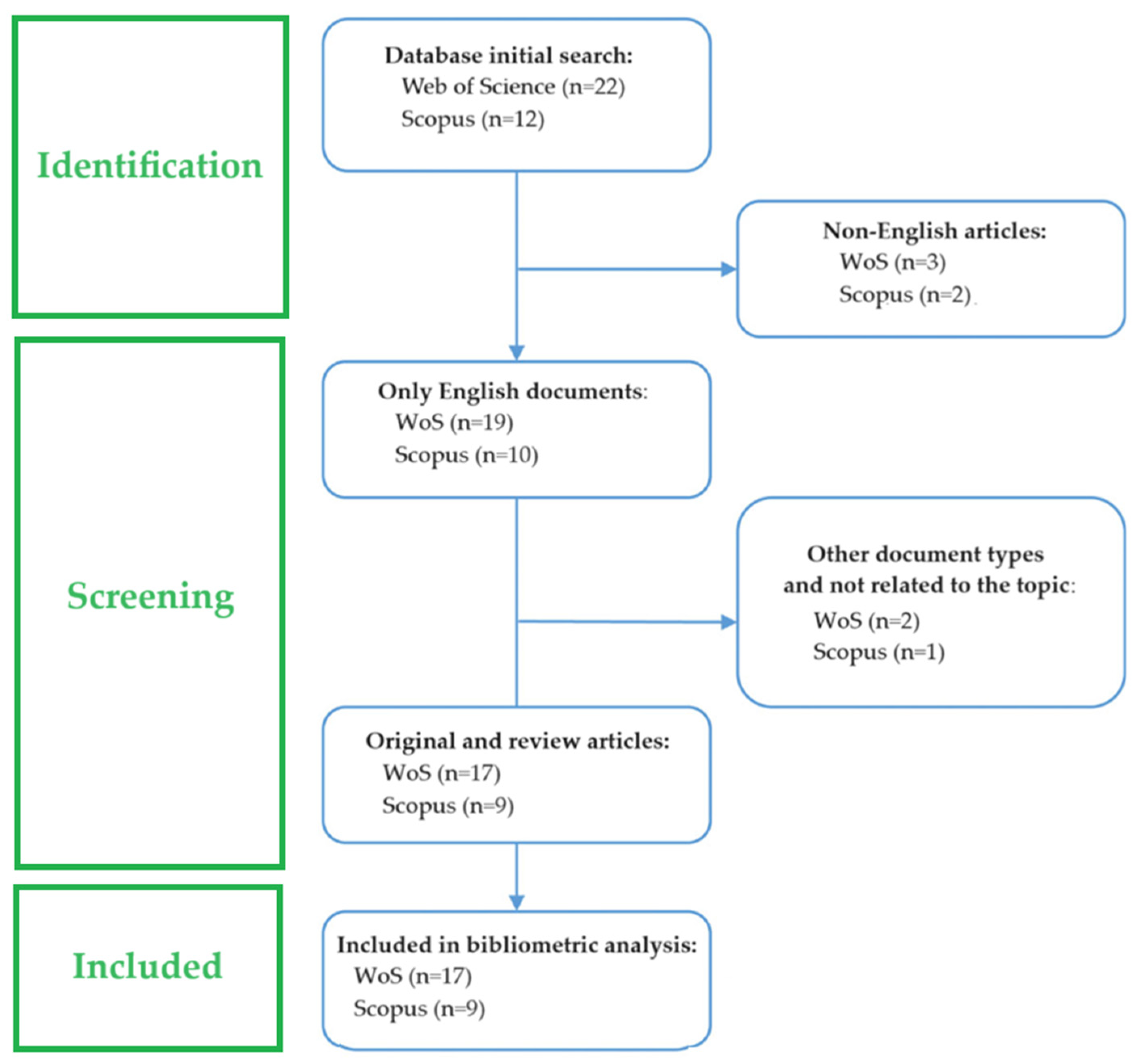
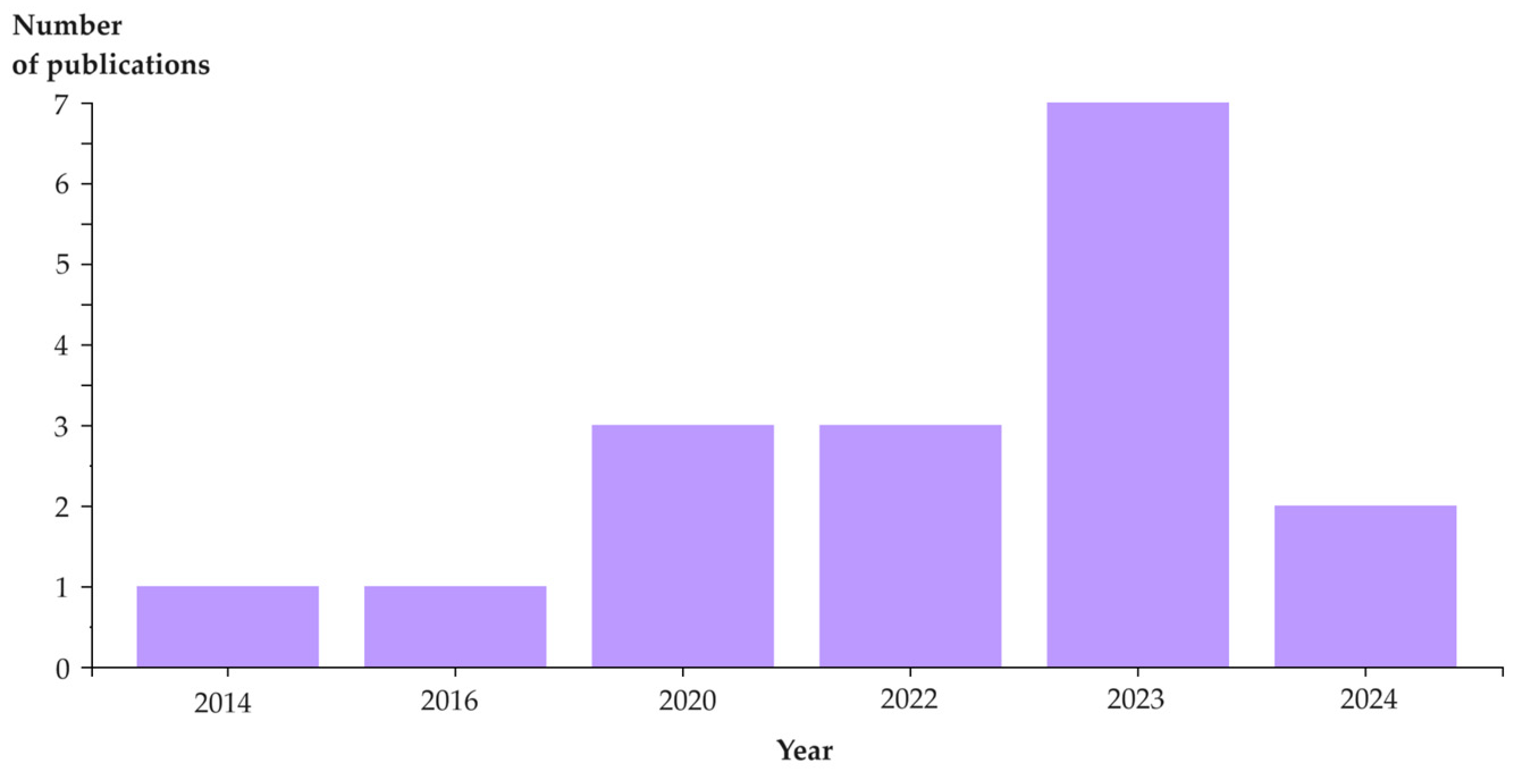

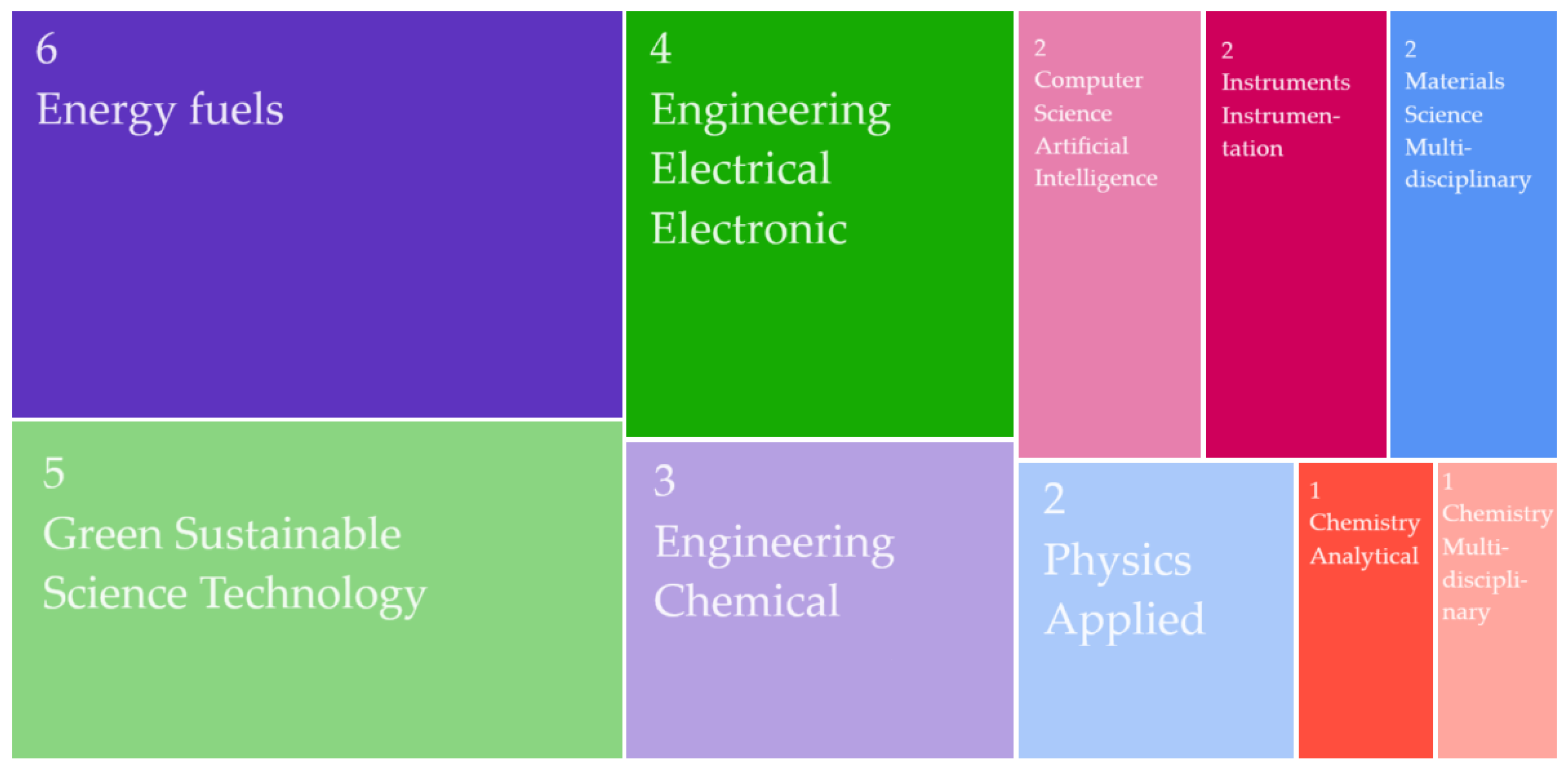

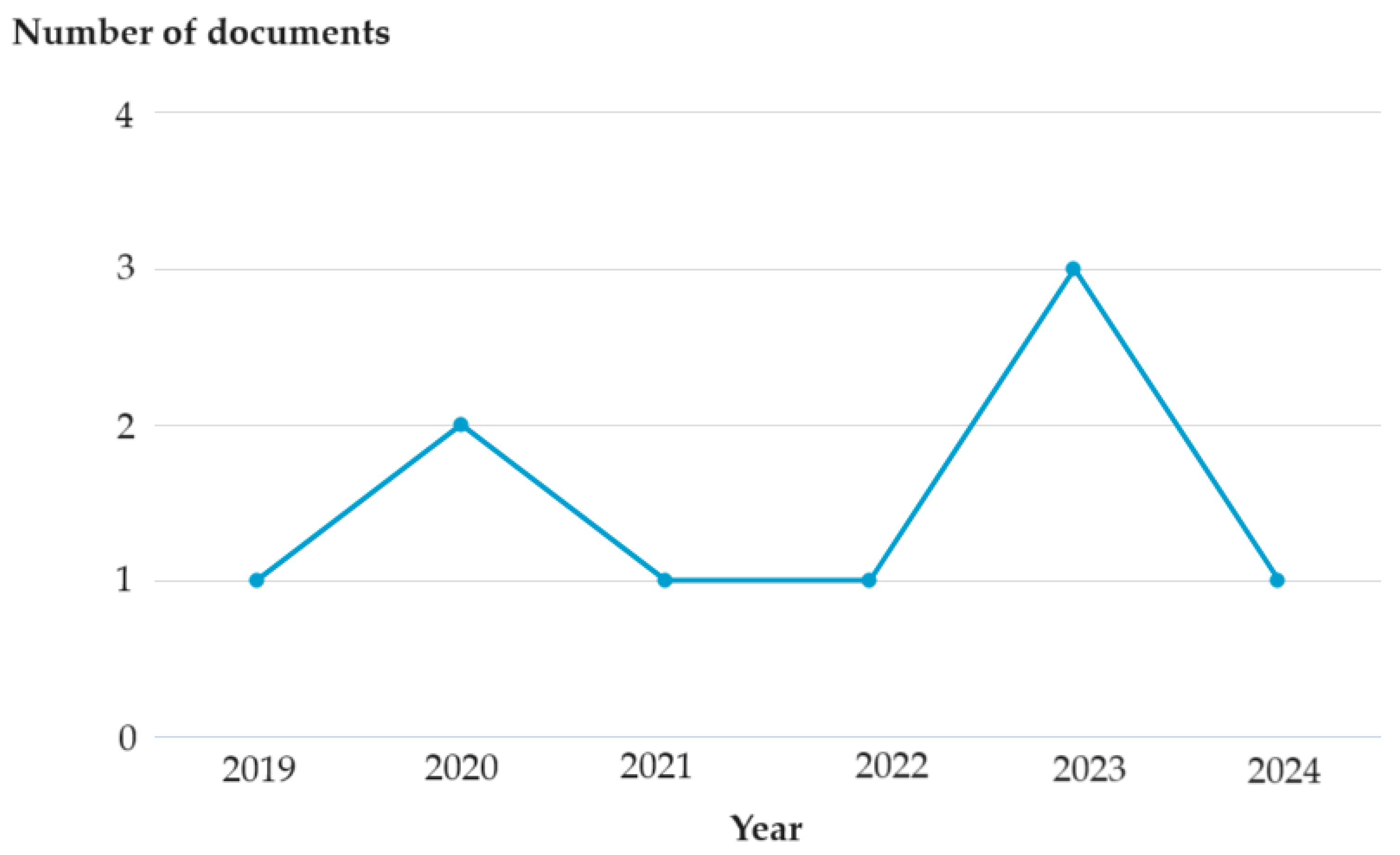
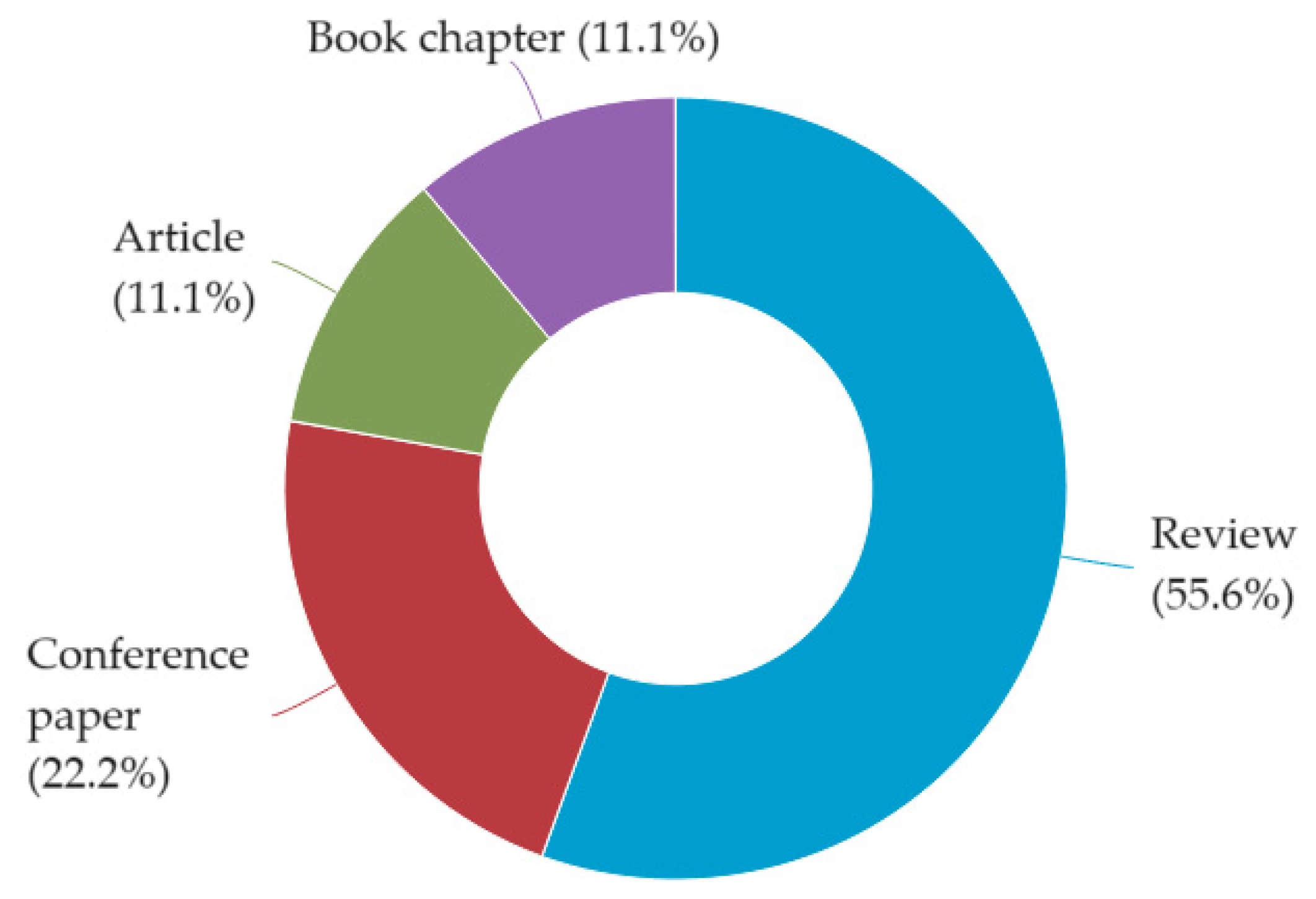

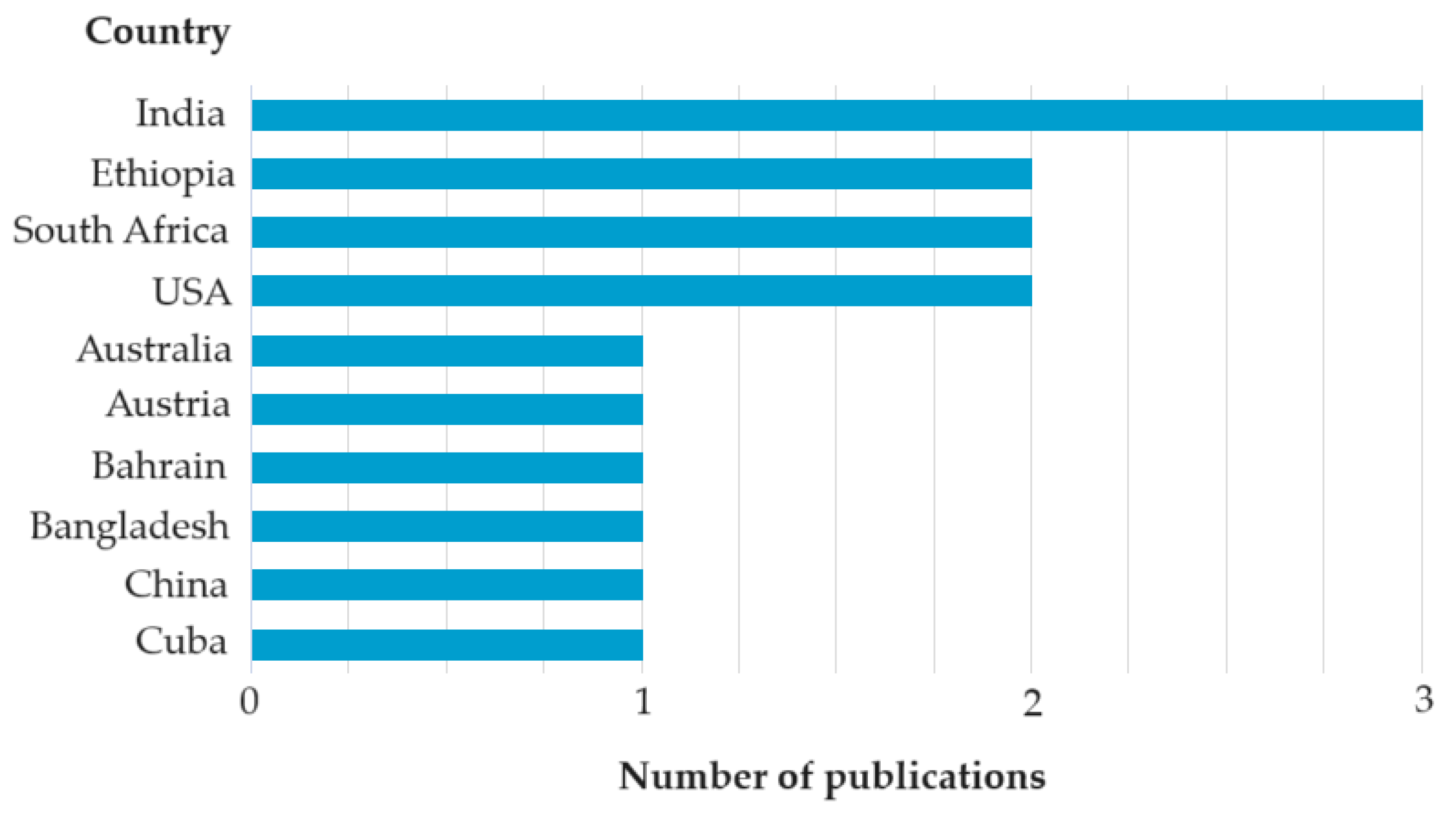

| Journal | Number of Articles [-] |
|---|---|
| Sustainability [18] | 1 |
| Journal of Composites Science [19] | 1 |
| Applied Sciences [20] | 1 |
| Journal of Electrochemical Science and Engineering [21] | 1 |
| International Journal of Green Energy [22] | 1 |
| International Conference on Advances in Green Energy (ICAGE) [23,24] | 2 |
| Solar Energy [25] | 1 |
| 4th International Conference on Artificial Intelligence and Evolutionary Computations in Engineering Systems (ICAIECES) [26] | 1 |
| Green Energy & Environment [27] | 1 |
| Biomass Conversion and Biorefinery [28] | 1 |
| ACS Applied Materials & Interfaces [29] | 1 |
| Futures [30] | 1 |
| IEEE Sensors Journal [31] | 1 |
| Sensors [32] | 1 |
| Journal of Experimental & Theoretical Artificial Intelligence [33] | 1 |
| Applied Energy [34,35,36] | 3 |
| Machine Learning and Computer Vision for Renewable Energy [37] | 1 |
| Virtual and Physical Prototyping [38] | 1 |
| Science of the Total Environment [39] | 1 |
| International Conference on Artificial Intelligence and Computer Vision (AICV2020) [40] | 1 |
| Engineering Applications of Artificial Intelligence [41] | 1 |
| Feature | FedPT-V2G [35] | GGNet [36] | Multi-Node Load Forecasting [41] |
|---|---|---|---|
| Type | Security-enhanced federated transformer learning for real-time V2G dispatch with non-IID data | A novel graph structure for power forecasting in renewable power plants considering temporal lead-lag correlations | Multi-node load forecasting based on multi-task learning with modal feature extraction |
| Technologies | Deep learning Federated learning Regularization to align local models | Granular-based graph neural networks Two-dimensional convolutional neural network Graph attention network | Gated temporal convolutional network |
| Algorithm | Proximal algorithm and Transformer model to handle Non-IID data in V2G tas | Graph structure can adapt to the lead-lag characteristic arising from the air flow, allowing it to dynamically capture the effects of lead and lag among RPPs. | IGTCN module is designed to extract the coupling features from different node loads |
| Dataset | End-to-end learning based on historical data to make V2G decisions in real-time | Real-world datasets, with wind power plants and photovoltaic power plants | Data from the New Zealand distribution network and AEMO |
| Application | Load shifting and PV self-consumption under diverse uncertainties | Power forecast for each renewable power plant (RPP) in the renewable energy clusters | Multi-node load forecasting in the power system |
| Performance | Achieve similar performance to centralized learning on both IID and Non-IID data | The proposed graph structure can reflect the lead-lag characteristics among RPPs caused by the atmospheric flow, obtaining better correlation representations among RPPs. | The multi-task deep neural network exhibits the accuracy of multi-node load forecasting |
| Accuracy for balanced datasets: 98.93%; imbalanced datasets: 92.20% | Forecast steps decreased on average by 48.95% and 18.75%, respectively | MAPE decreased by 17.04% and 3.92% in non-aggregation and aggregation situations, respectively |
Disclaimer/Publisher’s Note: The statements, opinions and data contained in all publications are solely those of the individual author(s) and contributor(s) and not of MDPI and/or the editor(s). MDPI and/or the editor(s) disclaim responsibility for any injury to people or property resulting from any ideas, methods, instructions or products referred to in the content. |
© 2024 by the authors. Licensee MDPI, Basel, Switzerland. This article is an open access article distributed under the terms and conditions of the Creative Commons Attribution (CC BY) license (https://creativecommons.org/licenses/by/4.0/).
Share and Cite
Rojek, I.; Mikołajewski, D.; Mroziński, A.; Macko, M. Green Energy Management in Manufacturing Based on Demand Prediction by Artificial Intelligence—A Review. Electronics 2024, 13, 3338. https://doi.org/10.3390/electronics13163338
Rojek I, Mikołajewski D, Mroziński A, Macko M. Green Energy Management in Manufacturing Based on Demand Prediction by Artificial Intelligence—A Review. Electronics. 2024; 13(16):3338. https://doi.org/10.3390/electronics13163338
Chicago/Turabian StyleRojek, Izabela, Dariusz Mikołajewski, Adam Mroziński, and Marek Macko. 2024. "Green Energy Management in Manufacturing Based on Demand Prediction by Artificial Intelligence—A Review" Electronics 13, no. 16: 3338. https://doi.org/10.3390/electronics13163338
APA StyleRojek, I., Mikołajewski, D., Mroziński, A., & Macko, M. (2024). Green Energy Management in Manufacturing Based on Demand Prediction by Artificial Intelligence—A Review. Electronics, 13(16), 3338. https://doi.org/10.3390/electronics13163338








